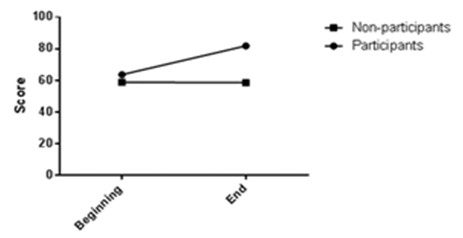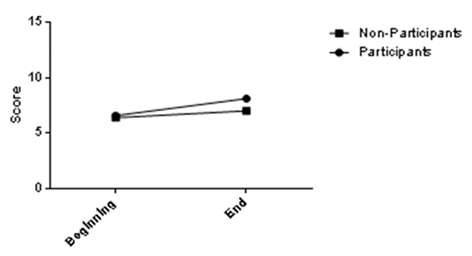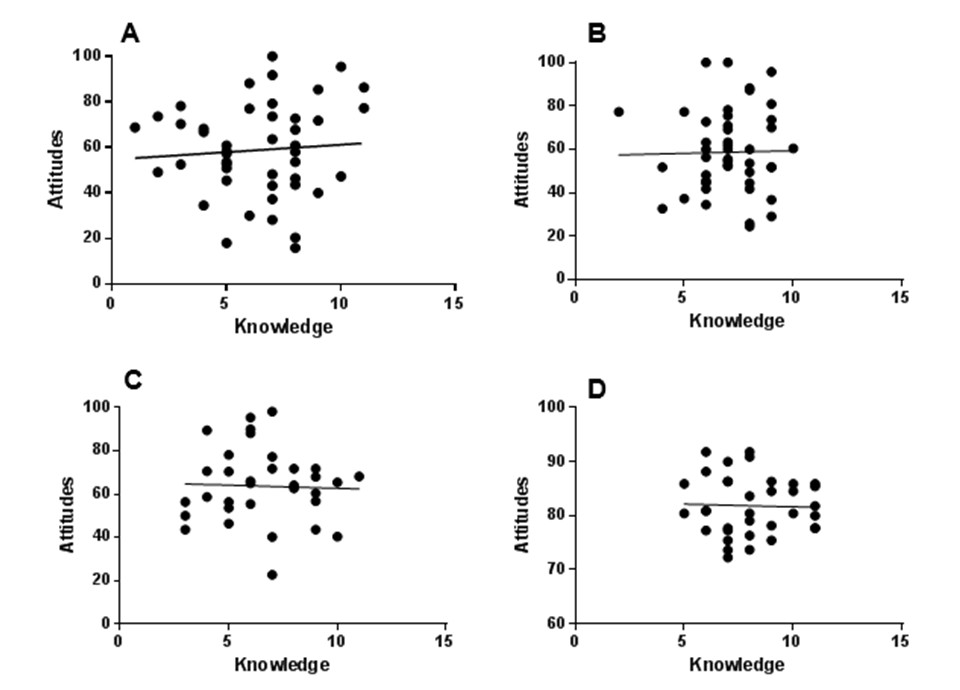-
Paper Information
- Paper Submission
-
Journal Information
- About This Journal
- Editorial Board
- Current Issue
- Archive
- Author Guidelines
- Contact Us
Education
p-ISSN: 2162-9463 e-ISSN: 2162-8467
2018; 8(2): 15-20
doi:10.5923/j.edu.20180802.01

Environmental Education Program as a Tool to Improve Children's Environmental Attitudes and Knowledge
Gabriela L. Schmitz1, João B. T. da Rocha2
1Programa de Pós-Graduação em Educação em Ciências: Química da Vida e Saúde, Universidade Federal de Santa Maria, Brazil
2Departmento de Bioquímica e Biologia Molecular, Universidade Federal de Santa Maria, Santa Maria, Brazil
Correspondence to: Gabriela L. Schmitz, Programa de Pós-Graduação em Educação em Ciências: Química da Vida e Saúde, Universidade Federal de Santa Maria, Brazil.
| Email: |  |
Copyright © 2018 Scientific & Academic Publishing. All Rights Reserved.
This work is licensed under the Creative Commons Attribution International License (CC BY).
http://creativecommons.org/licenses/by/4.0/

Environmental education is a way to achieve the sustainable development and preserve nature. One of the aims of environmental education is to improve student's environmental attitudes because this is expected to improve pro-environmental behaviors. To change environmental attitudes is a challenge to educators and some proposals have being made in the last decades. The main objective of this work was to analyze the effectiveness of an environmental education program as a way of boosting the students’ environmental attitudes and knowledge. The sample consisted of 82 eighth and ninth grade students of a public elementary school located in Brazil, divided into two groups (participants and non-participants). Results indicated a shift in the participants’ environmental attitudes to a more pro-environmental way and an improvement in the students’ environmental knowledge, whereas non-participants did not change their attitudes and knowledge during the year. Finally, neither gender nor grade influenced the students’ environmental attitudes. Our results suggest that the participation in environmental education program guided activities can be effective to improve the students pro-environmental attitudes and knowledge.
Keywords: Environmental attitudes, Environmental knowledge, Environmental program, Environmental education
Cite this paper: Gabriela L. Schmitz, João B. T. da Rocha, Environmental Education Program as a Tool to Improve Children's Environmental Attitudes and Knowledge, Education, Vol. 8 No. 2, 2018, pp. 15-20. doi: 10.5923/j.edu.20180802.01.
Article Outline
1. Introduction
- The humankind activity affects the environment direct and indirectly. The indiscriminate use of the natural resources to produce several goods can cause environmental imbalance [1-3]. After the findings that the natural resources are finite and their preservation are need to support humankind, environmental movements are debating and working to development of behavioural attitudes that will support the sustainability [4]. To attain behavioural changes, it is necessary that the individual's attitudes toward the attitudinal object change too [5]. According to the assumption of the Theory of Reasoned Action proposed by [6], the behaviours are indirectly related to the attitudes toward the behavioural intentions. The behaviour is determined by the intention to execute it and the intention is determined by the attitudes about the attitudinal object. Here in the present study, the environment is the object in question. In this way, it is assumed that the pro-environmental behaviours are predicted by the pro-environmental behavioural intentions that, in turns, are predicted by the pro-environmental attitudes [7].The behavioural intentions are understood as the predispositions of an individual to engage himself in a specific behaviour [8, 9]. On the other hand, pro-environmental attitudes are defined as a set of values and actions that renders the individual aware of the environment. Finally, pro-environmental behaviours are defined by Corral_Verdugo [10] as the collection of actions that leads to the environmental protection. As the attitudes are not directly observable [11, 12], they can be inferred by the self-reported behavioural intentions.The sustainable development involves daily practices that preserve a balanced human-nature relationship and consider the human’s actual and future needs. In this way, it is assumed that individuals with high concerns toward the sustainability will engage themselves into pro-environmental actions.The results of the unconcerned human activity towards the environment are considered a threat to the future of the planet. Consequently, it is necessary to develop attitudes and pro-environmentally oriented behaviours, since the attitudes and knowledge will determine the individual's environmental competence [13]. In this regard, the school can have an important role to attain this end. Pro-environmental attitudes are those that will preserve the environment [5].The relevance of the education on the development of the pro-environmental attitudes is obvious [14]. Stapp et al [14] established the term environmental education as the educational practices related to the environmental theme. The environmental education has a crucial role in the achievement of the sustainable development. The goals of the environmental education were established in the Tbilisi Conference in 1977. One of the goals is to develop positive attitudes toward the environment and individuals with pro-environmental attitudes are those that will promote the environmental preservation and diffuse pro-environmental attitudes and behaviours [15, 16]. Therefore, the environmental education aims to literate the students regarding the environment and its preservation [17].In Brazil, the environmental attitudes are expected to have a role in the basic education. According to the National Common Curricular Base [18], every Brazilian student should have access to environmental attitudes content. The attitudes possess a cognitive component [19] that is related to the individual’s knowledge about the attitudinal object [20]. In this way, another aim of the environmental education is to increase the student's knowledge about the environment. Accordingly, the individual's knowledge about the environment is positively associated with pro-environmental attitudes [21-24].Of particular educational importance, the efficacy of environmental programs dedicated to teach environmentally-friendly practices associated with theoretical lessons has been demonstrated by different authors [24-29]. For example, the study performed by Liefländer and Bogner [30] indicated that participation in short and long-term environmentally-friendly programs positively influenced the preservation attitudes of primary school students in Germany. Similarly, the perceptions of American students have been demonstrated to be more pro-environmental after the participation in an environmental programs [31]. In Brazil, few studies about the environmental attitudes have been performed [32-34]. In this context, the objective of this study was to analyse how the participation in an environmental education project influenced the student's environmental attitudes and knowledge. Specifically, we aimed to test the following hypothesis:1. The participation in the environmental education program will enhance the student's environmental attitudes as well as their knowledge about the environment in comparison with students who will not participate in the program.2. Environmental knowledge will be positively related to the student's environmental attitudes.3. The environmental attitudes of the female students will be significantly higher than that of the male students.4. The environmental attitudes of the older students will be significantly higher than that of younger students.
2. Methodology
2.1. Participants
- The students that composed this sample are described in Table 1. The total number of participants was 82 elementary students divided into two groups: Participants and nonparticipants of the environmental program. The students that answered the instrument and participated in the program are those enrolled in the ninth and eighth grades an public elementary school located in Rio Grande do Sul state, Brazil.
|
2.2. The Environmental Program
- Our environmental education program was called "Ações sustentáveis no ambiente escolar" (Sustainable practices in the scholar environment) and it was realized along the scholar year of 2017, one day each week, in the opposed turn of the student's regular classes. During the year, the student's participants in the environmental program performed some guided activities related to school waste (mainly on how to recycle/manage paper and food) and environmentally-friendly practices (for instance, how could them promote the diffusion of their practices to the other students of the school).
2.3. Data Collection
- Data were collected at the beginning and at the end of the year of 2017. Environmental attitudes were measured via an instrument composed of 11 items describing pro-environmental attitudes, with a Cronbach α of 0.9. Environmental Knowledge was measured using the Children's Environmental Knowledge and Attitudes Scale [35]. Only 15 items of the knowledge component of this scale were used, once these items are equivalent to the Brazilian curricular context.
2.4. Data Analysis
- Data were analyzed by four-way ANOVA [2 gender X 2 grades X 2 participation/non-participation in the program X beginning and end of the year (repeated measures)] with repeated measures to measure differences in the attitudes and knowledge between the two groups that composed this study. Linear Regression was performed to analyze the relationship between student's environmental attitudes and knowledge.
3. Results
- After students answered the instruments, data was analyzed and the results obtained are reported in Table 2. At the beginning of the year, the participants and non-participants scored similarly in their environmental attitudes and knowledge (see Figure 1).
 | Figure 1. Comparison between participants and non-participants environmental attitudes and knowledge at the beginning of the environmental education program |
|
|
4. Discussion
- The results obtained here indicated that the participation in the guided activity of the environmental education program improved the students' environmental attitudes and knowledge. These results are in accordance with the findings of several studies where the students' environmental attitudes increased after the participation in environmentally-friendly programs [36-38]. Taken together, we can hypothesize that the guided participation in activities in environmental education programs can positively influence the students’ environmental attitudes and knowledge. Consequently, the use of this type of programs can be a tool to promote the pro-environmental attitudes and knowledge in elementary schools.It was expected a correlation between students environmental attitudes and knowledge. Although, despite environmental attitudes and knowledge had increased along the program, neither to participants students nor non-participants, knowledge influence their environmental attitudes. In general, knowledge seems to be correlated with environmental attitudes, as Lienfländer and Bogner [15] and Paço and Lavrador [39] reported in their studies. However, these patterns were not observed in our sample. In addition, it was not found an influence of gender on the environmental attitudes of our sample. Grúñová et al [28] and Tucker and Izadpanhi [40] reported similar results. Others authors, for example, Walickzek, McFarland and Holmes [41] and Sahin and Erkal [42] reported differences between genders were girls showed more pro-environmental attitudes when compared with boys. Although, in our study, the participation in the environmental education program equally influenced boys and girls environmental attitudes. For Liefländer and Bogner [30] when the activities of a program are equivalent between genders expectations, they would equally influence both girls and boys. Finally, no differences were found between the school years, probably due the years are to close, only one year. However, even considered different stages of age showed not to be a factor on children's' environmental attitudes and knowledge, as it was reported by Tucker and Izadpanhi (2017).
5. Conclusions
- Our study demonstrates that the individual’s environmental attitudes and knowledge can be improved with the participation in an environmental education program. Environmental education appears to be an effective tool to change attitudes to promote pro-environmental behaviours forwarding to the sustainable development.
 Abstract
Abstract Reference
Reference Full-Text PDF
Full-Text PDF Full-text HTML
Full-text HTML




